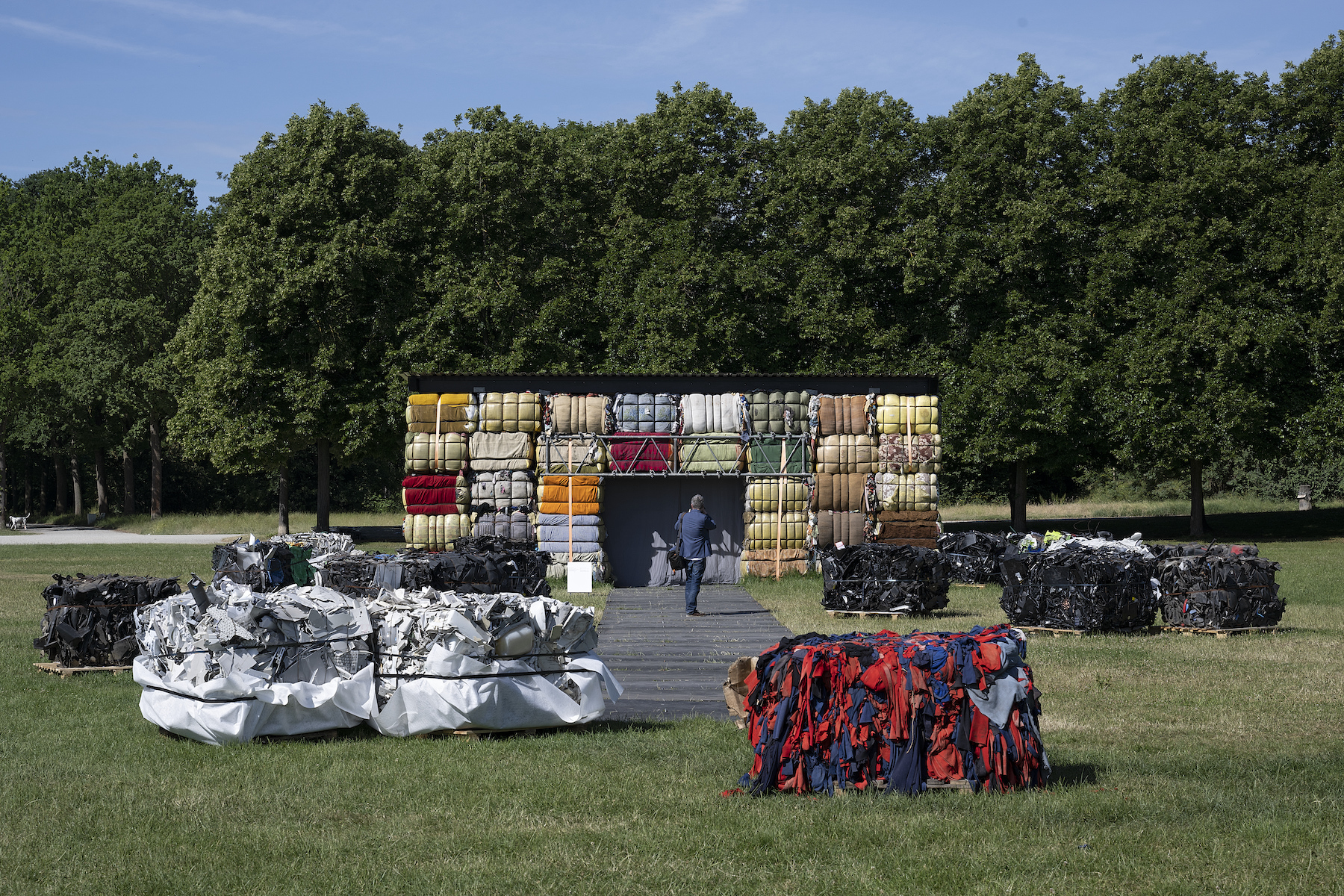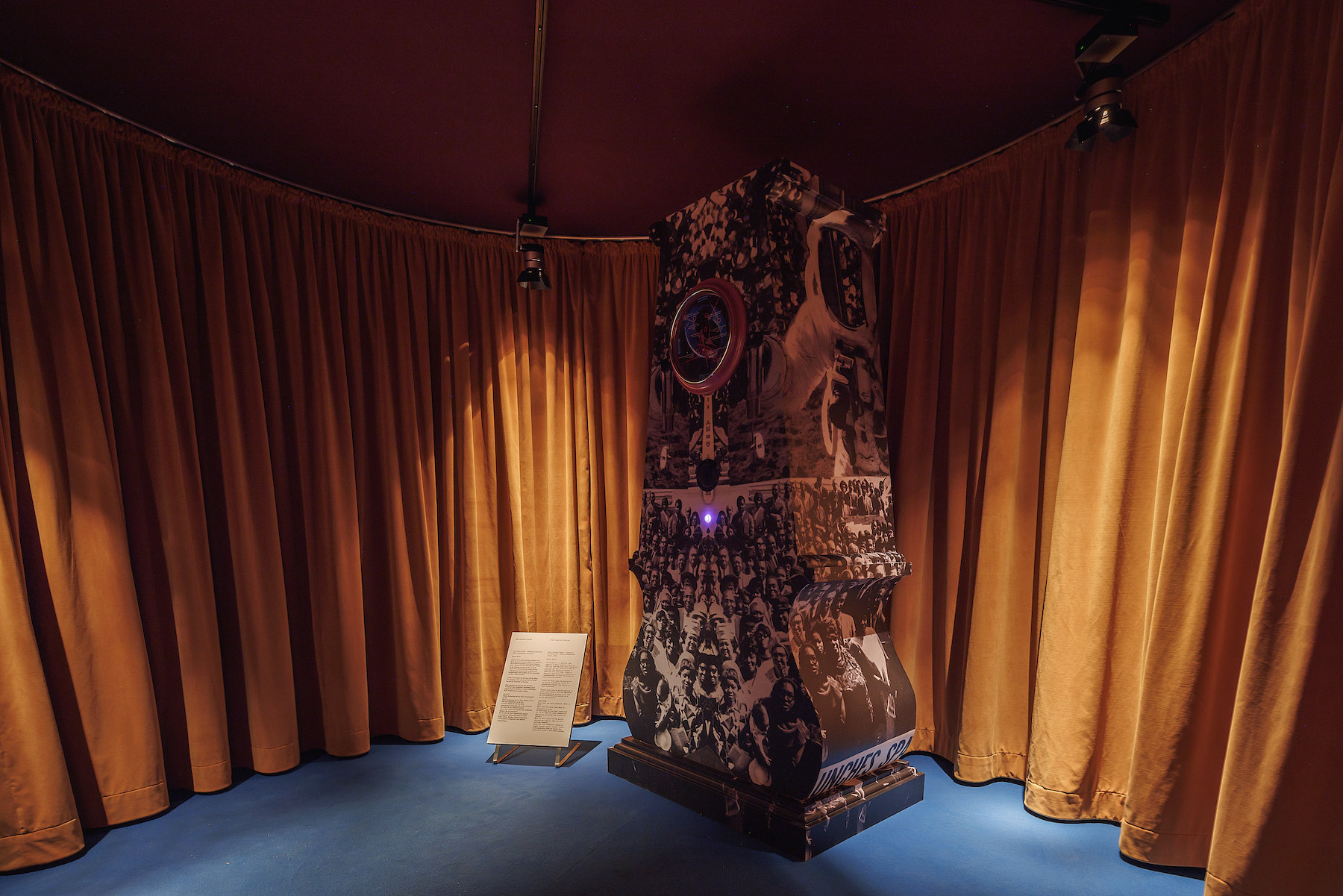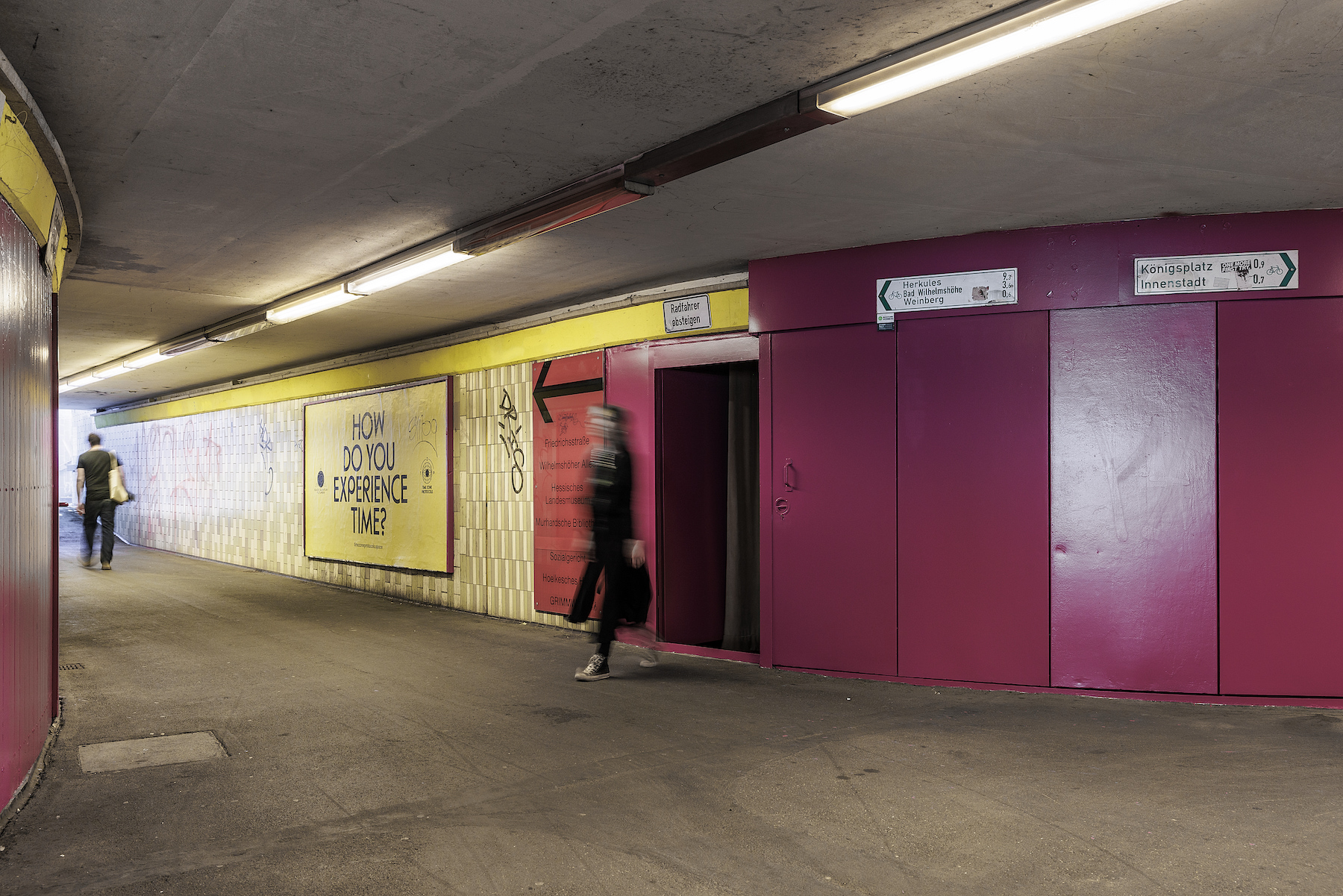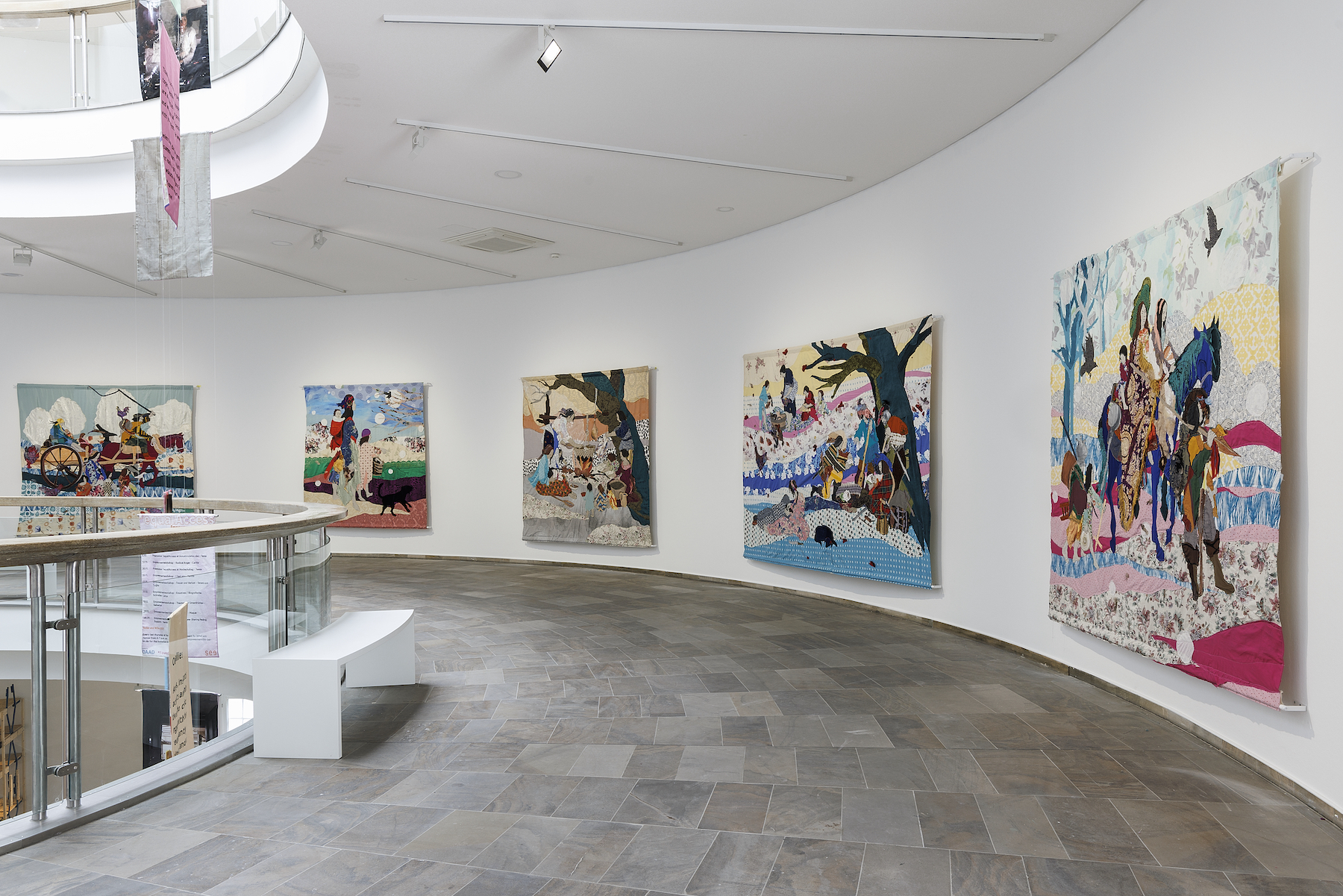A Movement of the Earth Against the World
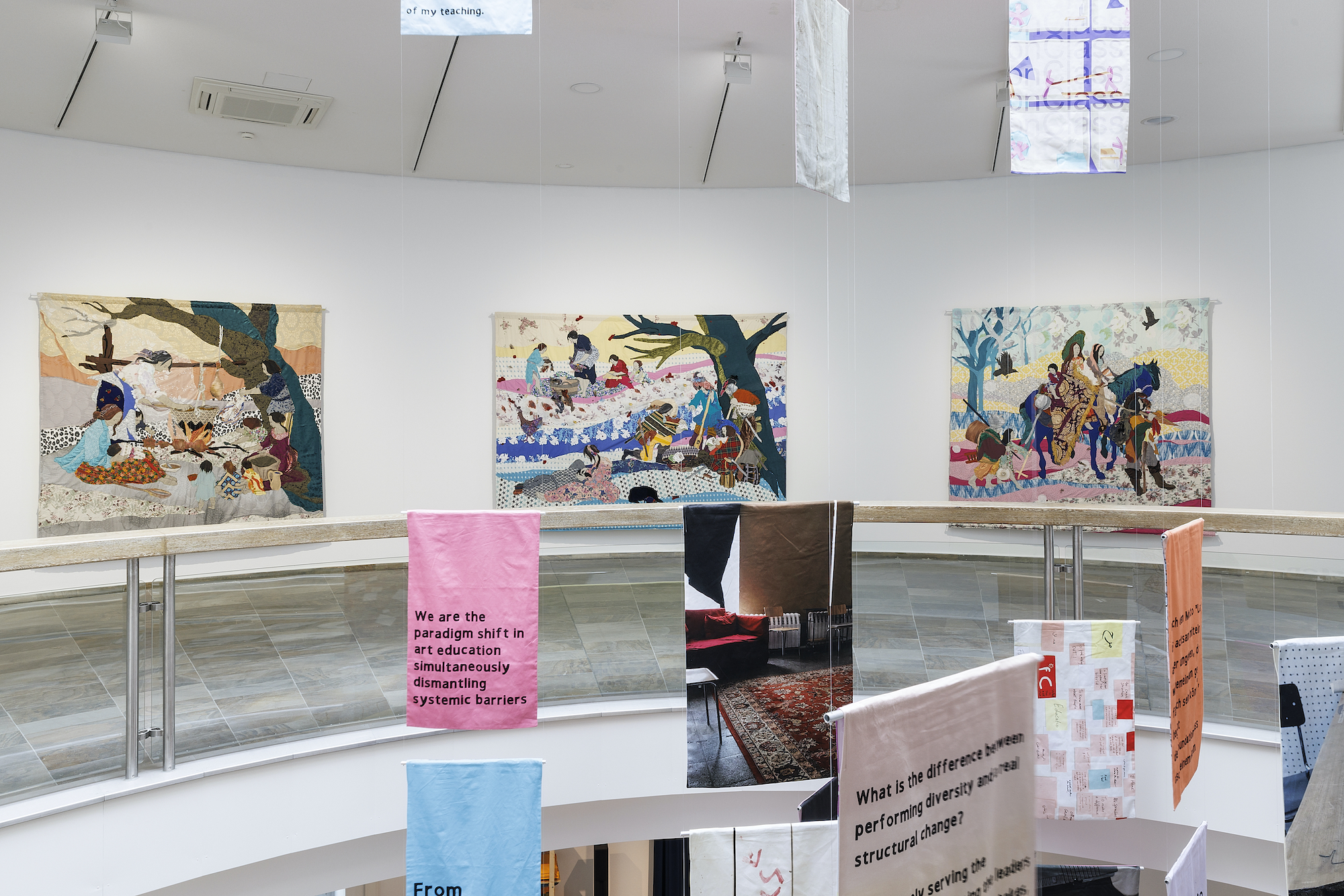
Małgorzata Mirga-Tas, Out of Egypt, 2021, installation view [photo: Frank Sperling; courtesy of the artist and documenta fifteen Fridericianum, Kassel]
Share:
Kassel has a fabled history. The Brothers Grimm emerged here during a paradigm shift that marked the amalgamation of Germany’s autonomous regions. Collecting and transcribing oral folktales into volumes, they transformed medieval tales into moralistic fables meant to inculcate children with the grand narrative of German exceptionalism that came to dominate a large part of the 20th century. In the aftermath of WWII—a period tied to the establishment of documenta in Kassel, now in its 15th edition—that narrative undergoes a painful but necessary undoing through confrontation with injustices experienced on a global scale and the imaginative, multiscalar, and potent ways that artists choose to deal with them.
In the exhibition catalogue, this documenta’s curators—the collective ruangrupa—decry the antisemitic writings within the diaries of Jacob and Wilhelm Grimm, but in the days after the opening, there were heated talks about an anti-Jewish caricature discovered on a massive mural titled People’s Justice. The 2002 artwork was created by the prolific group Taring Padi, which produced more than 100 posters, cardboard cut-outs, and various ephemera encompassing decades of practice. Images of fanged figures (Taring Padi translates to “fangs of rice,” referring to the sharp tips of such grain when unhusked), painted on cardboard cut-outs, populated the plaza in front of the documenta Halle and the Hallenbad Ost, a filled-in swimming pool wallpapered with posters, paintings, and prints of masses in revolt, anthropomorphic animal figures, and other caricatures of victims and oppressors from the vast vernacular that frames the Indonesian people’s struggle for sovereignty.
The Nest Collective, Return To Sender, installation view, 2022 [photo: Nils Klinger; courtesy of the artist and documenta fifteen, Karlswiese (Karlsaue), Kassel]
The caricature in question was a small detail, but certainly worth mentioning, as it pokes an unfortunately predictable hole in the national Vergangenheitsbewältigung (“coming to terms with the past”). In a statement that followed, ruangrupa’s Ade Darmawan apologized for the image and offered the explanation that antisemitic images came to Indonesia as part of an extended propaganda campaign by Western interests targeting Chinese nationals. Western byproducts circulate endlessly and irresponsibly in the Global South—such caricatures included. Nairobi-based Nest Collective’s installation Return to Sender—Delivery Details (2022), for example, illuminates the hypocrisy of Western do-goodery. The work, set against the palatial Orangerie, consists of neatly baled clothing and office supplies that form an enterable structure. Inside is a video explaining how up to 40% of our material donations to developing countries is, in fact, unusable garbage—illegal dumping under the guise of charity.
Black Quantum Futurism, Black Grandmother Clock (Oral futures booth), 2022, installation view [photo: Frank Sperling; courtesy of the artist and documenta fifteen, Kassel]
Black Quantum Futurism, Black Grandmother Clock (Oral futures booth), 2022, installation view (entrance)[photo: Frank Sperling; courtesy of the artist and documenta fifteen, FrankfurterStraße / Fünffensterstraße (underpass), Kassel]
“There’s a movement of the earth against the world,” write Fred Moten and Stefano Harney in “Base Faith” ( All Incomplete, 2021); “The earth is local movement in the desegregation of the universal: Here’s the door to the earth with no return home.” While looking for the door to this exhibition, I duck into an underpass at Fünffensterstrasse to encounter Black Grandmother Clock (Oral futures booth) (2021), an interactive installation and questionnaire by Philadelphia-based Black Quantum Futurism that feels quite belabored next to the simple but evocative text-based works that line the tunnel, but the question of alternative timelines raised in that work stays with me as I emerge at the other end. There, the Hessisches Landesmuseum delivers with Aşît (Avalanche/Lawine) (2022), a spectacular feature film by Berlin-based artist Pınar Öğrenci, centered on the hometown of her father. Located along Turkey’s southern border with Iran, Müküs is a former capital of the Urartian civilization and the Armenian Vaspurakan Dynasty, and today is home to many Kurdish-speaking communities. Inspired by Stefan Zweig’s final novella, The Royal Game (Schachnovelle) (1941), Öğrenci returns to Müküs to document the resilience of its peoples through lingering shots of coffee shop chess play, the clearing of an avalanche in the snow-capped mountains, and sheep. The footage is accompanied by an autobiographical narrative and songs collected by the Armenian musician, researcher, and historian Hayrik Muradayan, who was forced to flee Turkey in 1918. Sewn handkerchiefs, symbolic of mourning, separate the projection space from the museum’s entrance.
A friend of mine, artist and poet Tiziana La Melia, pointed out that many works in the exhibition feature herding. Grazing animals do not concern themselves with borders, and the kinship between humans and livestock far predates the moralistic tales that underpin Eurocentrism. Life is predicated upon the production cycle of the animal and its migratory needs. documenta 15 successfully wields large groups of people whose survival strategies, in the face of displacement, include art making. In the Fridericianum, Komîna Fîlm a Rojava (The Rojava Film Commune), from northeastern Syria, pursues cinema as a model for liberation. Established in the aftermath of a traumatic event—in 1960, a fire in the region’s only cinema caused the deaths of 298 children—the collective’s work self-organizes to create narratives that archive the indigenous musical, social, and linguistic histories of the area. Many of the Commune’s films include singing. The Lonely Trees (2017), in particular, beautifully elaborates upon the relationship between landscape and song: Interspersed with images of poppy fields and sheep on rolling hills, community members describe the practice of singing as an “incarnation of the soul of the earth” and recall that singing originated in the land as an oral tradition which encrypts the landscape—enveloping customs within seasons and hillsides.
At the Museum of Natural History Ottoneum, the INLAND platform, with international collaborators, built upon the premise of the museum as a space of ancestral curiosity. Artifacts and stories illustrate instances of cohabitation, embodied knowledge, and kinship economy. Here again, herding appears as a socioeconomic modality. Among such highlights are drawings by Miguel Sánchez “El Pajarito” Vargas—the last shepherd in Almonaster la Real (Spain)—collected by Susana Velasco, an architect and artist. The drawings are anchored in a small, smooth rock resembling a cow’s forefront, which Vargas reputedly liked to caress. Throughout the venue, artworks and texts related to stewardship grace walls and various display surfaces, interposed to the point where it is difficult to tell who contributed what. One exception is Hito Steyerl’s center-room installation of a high-production video that riffs on INLAND collective’s proposed crypto-lacto currency, Cheesecoin, by referencing Animal Spirits—a term coined by British economist John Maynard Keynes. Although Steyerl’s work—since removed at her request—is a well-intentioned and often hilarious reflection upon the aesthetics of economy, her trendy sensibilities felt cynical and out of place here.
Małgorzata Mirga-Tas, Out of Egypt, 2021, installation view [photo: Frank Sperling; courtesy of the artist and documenta fifteen Fridericianum, Kassel]
In a refreshing departure from the glamorously unbothered worlds of Venice and Basel, an exceptional degree of consideration has been afforded to children. In the Fridericianum, Graziela Kunsch set up a daycare, thus transforming the museum into a different site of utility. A neighboring space run by Gudskul functions as a self-organized learning place for people of all ages. And, at the Bootsverleih Ahoi, artist Eva Koťátková in collaboration with OFF–Biennale Budapest, created a playground to foster free play and correlative connections between dreams and reality through a series of soft sculptures that can be inhabited. Another collaboration from OFF is with the European Roma Institute for Arts and Culture in a project that questions the possibility of a “RomaMoMa” in the context of Roma resistance to nationalist segregation at the Fridericianum. Wonderful patchwork wall hangings by Malgorzata Mirga-Tas that depict everyday life center the segment and lead to a group survey of Roma artists, the most charmingly intriguing of which is a series of small, exuberant paintings with overlaid text by Mara Oláh (Omara). Farther up, on the top floor of the building, paintings and texts, part of Selma Selman’s work Platinum (2021), are executed on car hoods. The motif of labor and the circulation of meaning re-emerges in her treatment of scrap metal. Traces of platinum in the car parts were mixed with dirt in a process of extraction, and the precious metal was used to pour a small sculpture of an ax. Although questions about visas, nationalistic discourses, and mobility plagued this edition of documenta, the philosophical underpinnings of the Roma community offer an inner script—running in the background of European drama—to register and encrypt an alternative course of events, and even to spell out the possibility of a different world.
Unexpectedly, the door to this documenta is not the usual rabbit hole but a looking glass.
Xenia Benivolski curates, writes, and lectures about sound, music, and visual art. Her writing appears in art publications and academic journals such as e-flux journal, Artforum, Art-Agenda, Infrasonica, and Flash Art. She is editor and curator of You Can’t Trust Music at e-flux.com, a research project connecting sound-based artists, musicians, and writers to explore together how landscape, acoustics, and musical thought contribute to the formation of social and political structures. Xenia contributes to the Worker as Futurist project at Lakehead University.
